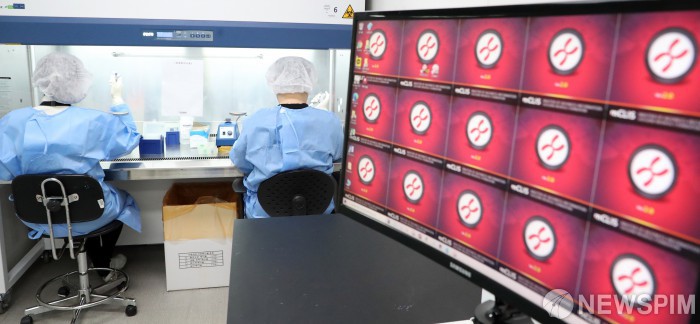Corrected after discovery of accounting errors in November 2019
Since 2016, after correction, sales have increased
There are’excessive’ accounts, but there are many’underlying’ accounts.
Difference in refund due to replacement of new products
[서울=뉴스핌] Reporter Seo Young-wook = Seegene was criticized by the Securities and Futures Committee of the Financial Services Commission that it had’spattered’ sales for eight years. However, as a result of the company revising its financial statements according to the guidelines, it was confirmed that sales and operating profits have increased since 2016.
In this regard, Seegene explained, “There are cases where sales were over-accounted, but rather under-accounted, and there was a difference in the process of exchanging products for new products.”
In the end, Seegene, which grew rapidly last year while developing the Corona 19 diagnostic kit, lit a blue light in achieving ‘1 trillion in sales’ by solving the risk of accounting processing before Corona 19-related sales began in earnest.
According to Seegene on the 10th, the company revised its financial statements to reflect all accounting-related situations in the third quarter of 2019.
Previously, on the 8th, the Jeungsun Committee pointed out that Seegene voluntarily exported excessive quantities of products that exceed the actual order volume to the agency from 2011 to the first half of 2019, and recognized all of them as sales, and over or underestimated sales, cost of sales, and related assets. There is a bar.
 |
| [서울=뉴스핌] Reporter Jeong Il-gu = Seegene researchers are analyzing and testing a novel coronavirus infection (Corona 19) at Seegene Medical Foundation Molecular Diagnosis Center in Seongdong-gu, Seoul on the afternoon of the 6th. 2021.01.06 [email protected] |
◆ Exaggerated financial statements were corrected two years ago..
According to Seegene’s business report revised in November 2019, sales were actually overestimated in 2014 and 2015, while sales from 2016 to 2019 were rather understated.
Seegene corrected that it overestimated sales of 5.3 billion won in 2014 and 7.8 billion won in 2015.
Based on this, the consolidated comprehensive income statement rewritten in 2014 decreased by 8.23% from KRW 64.4 billion in sales to KRW 59.1 billion, and operating profit decreased by 59.52% from KRW 8.4 billion to KRW 3.4 billion. In 2015, sales decreased by 11.98% from 66.5 billion won to 57.3 billion won, and operating profit decreased 98.44% from 6.4 billion won to 100 million won.
On the other hand, from 2016, sales were rather understated. Seegene corrected that it underestimated sales of 400 million won in 2016, 2.1 billion won in 2017, and 14.4 billion won in 2018.
According to the consolidated comprehensive income statement, sales increased 0.54%, 2.30%, and 1.49% from 2016 to 73.4 billion won to 73.8 billion won, 86.9 billion won to 88.9 billion won in 2017, and 102.3 billion won from 108.3 billion won in 2018.
During the same period, operating profit also increased by 26.83%, 7.04%, and 17.78% to 8.2 billion → 10.4 billion won, 7.1 billion → 7.6 billion won, and 9 billion → 10.6 billion won, respectively.
Sales in the 2019 half-year report were also underestimated by 1.3 billion won, so consolidated sales increased from 55.4 billion won to 56.8 billion won and operating profit from 9.2 billion won to 10.5 billion won.
An official from Seegen said, “There was a case where a dealer bought a product with high technology and bought a product in excess of the sales capacity and requested a refund when it was not sold properly. There is no regulation to refund the sold product, but From a business point of view, we implemented a refund, and in the process, there was a situation where the amount was reduced.”
The official added, “From 2016 to 2017, when Seegene’s self-developed technology was developed, there was a case in which the difference occurred in the process of replacing the product to which the technology was not applied with a new product, resulting in an understated case.”
◆Amendment guidelines were released in 2018, but accounting for the pharmaceutical and bio industry’jagged’
It is not true yesterday and today that the uncertain accounting problem in the pharmaceutical and bio industry was pointed out.
Although the improvement was improved with the release of the’Supervisory Guidelines on R&D Cost Accounting for Pharmaceutical and Bio Companies’ in September 2018, there is still confusion over the issue of accounting for enormous R&D expenses.
An official in the securities industry said, “Accounting fraud in the bio industry is a recurring issue from the past to the present,” he said. “There are cases where it is implicit in order not to suffer disadvantages such as delisting or suspension of transactions by financial authorities.”
However, in the case of diagnostic companies such as Seegene, it remains controversial whether it is reasonable to receive the same guidelines as pharmaceutical companies that develop pharmaceuticals.
Seegene also had a case in which sales were rather underestimated, but the accounting error was acknowledged due to over-counting of intangible assets and under-counting of current R&D expenses.
However, industry opinion is that Seegene, which develops diagnostic kits, receives the same guidelines as pharmaceutical companies that develop drugs, and errors may occur.
An industry official said, “In the case of the pharmaceutical industry, there is a regulation that it is necessary to conduct phase 3 clinical trials for product development and to capitalize development costs after phase 3,” he said. “However, Seegene does not proceed to phase 3, but product development physiology “The problem occurred when different pharmaceuticals and bios were grouped into one category.”
An official from Seegen said, “There are various difficulties, but we are improving in the direction of complying with the guidelines to comply with the relevant laws and regulations.”
